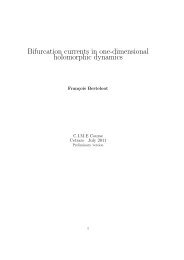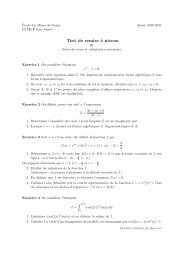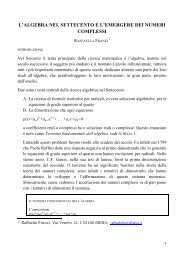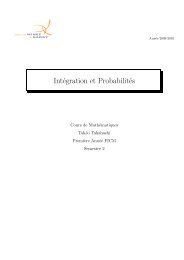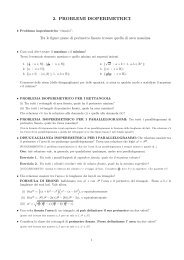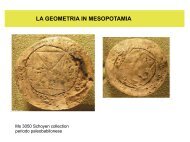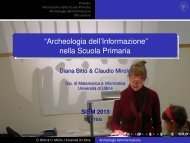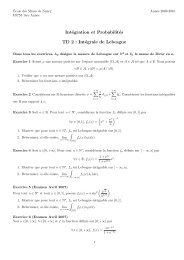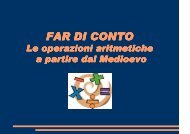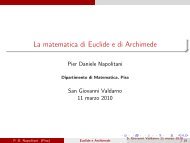Derivation of a fundamental diagram for urban traffic flow
Derivation of a fundamental diagram for urban traffic flow
Derivation of a fundamental diagram for urban traffic flow
You also want an ePaper? Increase the reach of your titles
YUMPU automatically turns print PDFs into web optimized ePapers that Google loves.
D. Helbing: <strong>Derivation</strong> <strong>of</strong> a <strong>fundamental</strong> <strong>diagram</strong> <strong>for</strong> <strong>urban</strong> <strong>traffic</strong> <strong>flow</strong> 9<br />
(u i −σ i u 0 i ) ̂Q i kT cyc < 0ineachcycle<strong>of</strong>lengthT cyc .Counting<br />
the number <strong>of</strong> cycles since the re-entering into the<br />
congested regime by k ′ ,wehave<br />
ΔNi<br />
min (u i ,k ′ )=ΔN jam<br />
i +(u i − σ i u 0 i ) ̂Q i k ′ T cyc , (71)<br />
and considering equation (15), the maximum number <strong>of</strong><br />
delayed vehicles is<br />
ΔNi<br />
max (u i ,k ′ )=ΔNi min (u i ,k ′ )+u i (1 − σ i u 0 i ) ̂Q i T cyc .<br />
(72)<br />
As soon as ΔNi<br />
min (u i ,k ′ ) reaches zero, the road section<br />
used by vehicle stream i enters the undersaturated regime.<br />
Be<strong>for</strong>e, the number <strong>of</strong> stops <strong>of</strong> vehicles joining the end <strong>of</strong><br />
the vehicle queue are expected to experience an number<br />
n s + 1 <strong>of</strong> stops with<br />
⌊<br />
n s (k ′ ui k ′ ⌋<br />
)=<br />
σ i u 0 , (73)<br />
i<br />
compare equation (58).<br />
Fig. 4. Schematic illustration <strong>of</strong> the service <strong>of</strong> vehicle queues,<br />
when the road section is fully congested. The lower horizontal<br />
line indicates the location <strong>of</strong> the upstream end <strong>of</strong> the road section.<br />
It can be seen that vehicles are stopped several times, and<br />
that new vehicles can only enter when some vehicles have been<br />
served by the <strong>traffic</strong> light located at the t-axis, and the space<br />
freed up by this has reached the end <strong>of</strong> the vehicle queue. For<br />
similar considerations see reference [35]. Note that the characteristic<br />
speed c 0 <strong>of</strong> the shock fronts (which corresponds to<br />
the slope <strong>of</strong> the congested <strong>flow</strong>-density relationship <strong>for</strong> a road<br />
section without the consideration <strong>of</strong> <strong>traffic</strong> lights) is different<br />
from the slope <strong>of</strong> the <strong>urban</strong> <strong>fundamental</strong> <strong>diagram</strong>, because <strong>of</strong><br />
the effect <strong>of</strong> signal <strong>of</strong>fsets and delays [31]. There<strong>for</strong>e, c 0 should<br />
be understood as fit parameter, here.<br />
and the average delay time Ti av = T i −Ti<br />
0 as<br />
T av<br />
i<br />
(u i ,σ i ,L i )= L iρ jam<br />
i<br />
σ i u 0 ̂Q<br />
− L i<br />
i i<br />
V 0<br />
i<br />
. (70)<br />
Note that these values are now independent <strong>of</strong> both, the<br />
utilization and the average density, as soon as the latter<br />
assumes the value ρ av<br />
i = ρ jam<br />
i , corresponding to a fully<br />
congested road section.<br />
5.1 Transition from oversaturated to undersaturated<br />
<strong>traffic</strong> conditions<br />
If the arrival <strong>flow</strong> A i after the rush hour drops below<br />
the value <strong>of</strong> σ i u 0 i T cyc max , the vehicle queue will eventually<br />
shrink, and the road section used by vehicle stream i enters<br />
from the oversaturated into the congested regime.<br />
The <strong>for</strong>mulas <strong>for</strong> the evolution <strong>of</strong> the number <strong>of</strong> delayed<br />
vehicles are analogous to equations (53) and(54).<br />
The queue length starts with ΔN jam<br />
i<br />
and is reduced by<br />
6 Summary and outlook<br />
Based on a few elementary assumptions, we were able to<br />
derive <strong>fundamental</strong> relationships <strong>for</strong> the average travel<br />
time Ti<br />
av and average velocity Vi<br />
av . These relationships<br />
are functions <strong>of</strong> the utilization u i <strong>of</strong> the service capacity<br />
<strong>of</strong> a cyclically signalized intersection and/or the average<br />
number ΔNi<br />
av <strong>of</strong> delayed vehicles (or the average density<br />
ρ av<br />
i <strong>of</strong> vehicles in the road section <strong>of</strong> length L i reserved <strong>for</strong><br />
<strong>traffic</strong> stream i). We found different <strong>for</strong>mulas, (1) <strong>for</strong> the<br />
undersaturated regime, (2) <strong>for</strong> the congested regime, and<br />
(3) <strong>for</strong> the oversaturated regime. While we also discussed<br />
situations, where fixed cycle times Tcyc 0 are applied, we primarily<br />
focussed on situations, where the cycle time is adjusted<br />
to the utilization u i (in the undersaturated regime)<br />
and to the effectively usable green time fraction σ i (in the<br />
oversaturated regime). Our results are summarized in Figure<br />
5, where also a comparison with the capacity restraint<br />
function (1) ismade.<br />
The <strong>for</strong>mulas <strong>for</strong> the non-congested regime can be either<br />
expressed as non-trivial functions <strong>of</strong> the utilization<br />
u i or the average queue length ΔNi<br />
av (or the average density<br />
ρ max<br />
i ). They contain a fit parameter ɛ i , which reflects<br />
effects <strong>of</strong> variations in the arrival <strong>flow</strong> and relates to the<br />
efficiency <strong>of</strong> <strong>traffic</strong> signal operation in terms <strong>of</strong> synchronizing<br />
with vehicle platoons. In the best case, delay times<br />
are zero, which shows the great optimization potential <strong>for</strong><br />
<strong>traffic</strong> control in this regime.<br />
In the congested regime, the number <strong>of</strong> delayed vehicles<br />
grows in time, and the majority <strong>of</strong> vehicles is stopped several<br />
times by the same <strong>traffic</strong> light. There<strong>for</strong>e, the average<br />
travel time does not only depend on the utilization u i , but<br />
also on the average vehicle queue ΔNi<br />
av (or the average<br />
density ρ av<br />
i ). Although the <strong>traffic</strong> light control can still improve<br />
the average travel times by synchronizing with the<br />
arrival <strong>of</strong> vehicles, the related efficiency effect is rather<br />
limited.



